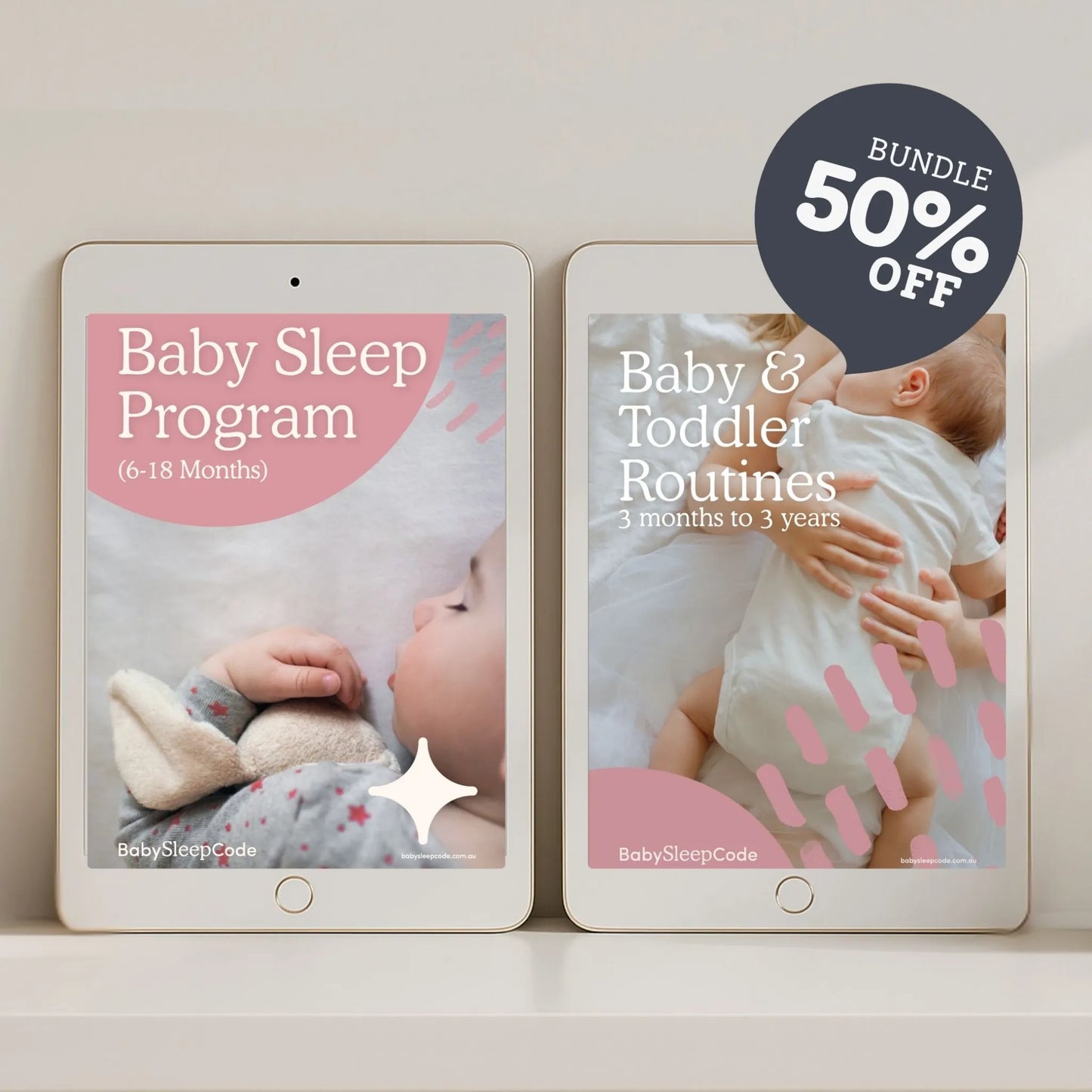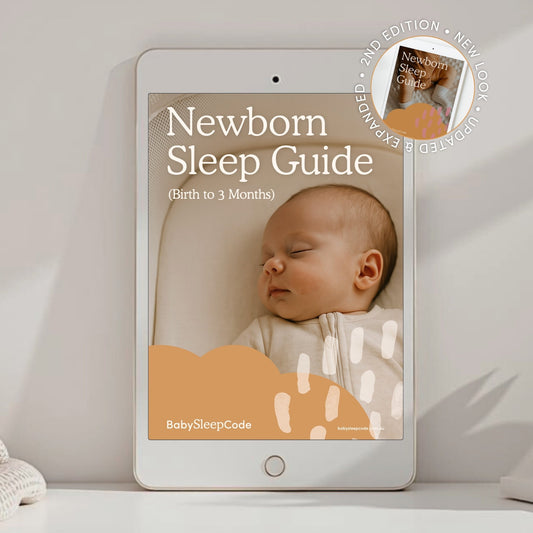Watching your little one go through separation anxiety can be challenging, but it can be helpful to know that it's a very normal and healthy part of their development. As parents, we can provide the support and reassurance they need to navigate this stage while also maintaining great sleep patterns.
When does baby separation anxiety start?
The first bout of separation anxiety typically occurs between 7-9 months. This is when a baby learns ‘object permanence” - and realizes that things, and people, continue to exist even when they can’t see them.
It’s around here, that they also start to understand that they are separate individuals from their primary caregivers. It's a big cognitive leap for them!
This idea can be unsettling to them at first, as they have only just noticed that a parent can leave. They also don’t understand the concept of time or space, so whether mum is just out of sight, in the next room, or away at work, it's all the same to them.
Imagine this scenario: You're sitting beside your baby and get up to go the bathroom when your baby notices you’re no longer in their line of vision they start to cry. They don't comprehend that you’re still nearby, or that you'll be back shortly. Babies who are beginning to be mobile will also start to notice the distance between you, and the effort required for them to get close to you again - so might start to cry before you’ve even left the room!
Separation anxiety will also peak again around 12-16 months old, often when a child starts at daycare or their main caregiver returns to work.
What are the signs of separation anxiety?
It's important to note that every baby is unique, and not all babies will display all of these, but here are the most commonly noted signs of separation anxiety:
- Clinginess: They become clingy and don't want to be put down or held by anyone other than their primary caregiver.
- Crying and fussiness: They may cry excessively or become more fussy, especially when their caregiver is out of sight or leaves the room.
- Fear of strangers: They may show fear or distress when approached or held by unfamiliar people.
- Difficulty with transitions: They may have trouble transitioning from one caregiver to another or from one environment to another.
- Seeking constant reassurance: They may constantly seek attention, interaction, or physical contact from their caregiver.
- Sleep disturbances: Separation anxiety can affect their sleep, but usually you’ll notice this impacting bedtime the most. (If they still fall asleep happily and independently at bedtime, but then wake often in the night, it's usually a separate regression not related to separation anxiety).
Is baby separation anxiety normal?
Yes, it’s a very normal and healthy sign of cognitive development and something all children must go through. It's worth noting that when your little one shows reluctance to separate from you, it signifies the healthy attachment that has developed between the two of you.
As they experience more moments of safe separation and their concept of time improves, they will come to recognize that you always return after being away. This realization brings them comfort during your absence and allows them to develop essential coping skills and a growing sense of independence.
Does separation anxiety affect sleep?
When it comes to the impact of separation anxiety on baby sleep, the extent of disruption can vary depending on the child's existing sleep routine and level of comfort with falling asleep independently. Babies and toddlers who already have a predictable sleeping pattern and feel secure and content in their sleep environment may not be as significantly affected. But, for those who haven't established a consistent sleep situation, separation anxiety can exacerbate existing sleep disruptions.
During this stage, babies may become more clingy and much more vocal about their wants to stay close to you. This can lead to new difficulties at bedtime, frequent night wakings, and a stronger reliance on parental presence to settle back to sleep. Some parents find that they’re also much harder to be placed down asleep now as they wake right up when transferred to their cot.
How to help my baby through separation anxiety?
Here are some simple strategies to support your little one through this phase and help to boost their sense of security, while maintaining a consistent sleep routine.
Check your own emotions:
As parents, we can’t help but feel a little anxious ourselves during drop-offs or messy bedtimes, but these feelings of anxiety can inadvertently affect how our children feel. It's essential to practice mindfulness and manage our emotions, projecting a positive attitude.
At sleep times it’s even more important to project how you would like them to feel, we have a much bigger chance of helping them feel calm if we are calm ourselves. By modelling a sense of confidence, we can help our little ones feel reassured during any transition. If your little one is starting childcare soon, check out our blog on Managing Sleep at Childcare.
Practice separation through play:
Peek-a-boo is a classic game that can work wonders in helping ease separation anxiety. Start with smaller transitions by hiding behind a blanket and then quickly reappearing with a big smile. Gradually extend the time you're out of sight, always returning with bravado.
Then practice leaving the room, and continue chatting with them after you leave their line of sight, reassuring them that you're close by. Begin by leaving them (in a safe position or playpen) for short periods and gradually increase the duration as your baby begins to feel more at ease. Getting them engaged in play before you leave can help keep them occupied and feel ok with being alone in these brief periods.
Introduce a comfort item:
Introducing a small lovey or comforter toy can help with transitions, both at sleep times and at daycare drop-offs. After a while their comfort item becomes their trusted companion. It's like having a piece of you there with them, even when you're not physically present.
When choosing a lovey for your baby, I recommend a small handkerchief-sized one made from breathable fabric and natural fibers, rather than synthetic which is not safe to chew. Make sure there are no loose fabrics, buttons or beads that might come loose and pose a choking hazard.
Hint: Buy two so you can keep them on rotation, washing one while they use the other. Plus you never want to be caught out if they loose one at daycare!
In Australia, RedNose.org.au safe sleep guidelines recommend waiting until a baby is at least over 7 months before introducing a comfort item, whereas the AAP recommend waiting until over 12 months. Always consider your baby’s own circumstances or consult your pediatrician as to whether it is safe to use during sleep times under 12 months.
Nurturing through the separation:
When our little ones experience separation anxiety, it can be really tempting to just carry them all the time to avoid any crying (no one likes to hear their baby cry even if you know they're ok). I’ve spoken to so many parents who’ve said to me during a consult - “whenever I go to place them down they start to cry, so I just don’t set them down”. But you want to make sure that you're not inadvertently reinforcing that their feelings of distress are warranted.
Try to lead with confidence and still place them down with lots of reassurance - so you can start to show them, little by little, that leaving and returning is normal and that they are still ok! A good thing to try is to sit with them for awhile first, get them engaged in an activity next to you, and then go do another task a little further away. Sometimes what can be perceived as separation anxiety is actually just a bit of FOMO (fear of missing out).
Keep regular routines:
Babies pick up on patterns and sequences of events from a very early age, and it’s the consistency we have in our routines that helps to provide a sense of stability and security. They feel reassured in knowing exactly what to expect next.
When babies are familiar with the sequence of events leading up to separation it helps them feel more prepared and in control. Think of a couple of comforting steps that you'll always do before periods of separation. Before sleep times, maybe it's a cuddle and a song, at daycare drop-offs perhaps you’ll hand them their lovey and give them a kiss before saying goodbye.
These routines also help children understand that even though they may temporarily part ways with their parents, they can rely on the routine to bring them back together again.
Don’t linger:
Studies show that during daycare drop-offs it’s best not to linger as this can prolong or increase any feelings of separation anxiety. This can be the same for sleep times. If your baby is usually a very content independent sleeper and are suddenly protesting once you’ve laid them down in their cot. Stay super calm, and predictable in your response.
If they’re protesting a lot at sleep times, or getting really emotional it might be time to rethink your pre-bedtime rituals. Do they need a longer wind down, do they need to release more energy before bed, do their routine timings need adjusting?
Need help getting sleep on track?
If it’s been weeks of bedtime battles or disrupted nights it might be time to book a Sleep Consult Package or grab our self-paced Baby Sleep Program to get sleep on track again.
"Thanks to this program, my husband and I get our nights to ourselves again. And our baby girl is sleeping 12 hours consistently overnight. With 2 solid day naps. From feeding to sleep every feed, endless contact naps and early rises, I never thought we would see this day. We are such a well rested and happy family thanks to this sleep guide." Chloe
“It didn’t take Amelia long to adjust to this transition, once she did I could tell she was thriving (& so were we!) After 3 nights on her new routine she had her first 12hr stretch of sleep & hasn’t turned back!” Taylor, Colorado Springs, USA
















